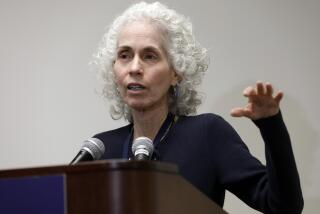State to step up inspections at hospitals with high infection rates
- Share via
After complaints that the state is doing little to stop deadly hospital outbreaks, the California Department of Public Health said this week that it would prioritize inspections at those facilities with high rates of patient infections.
The state disclosed the changes in a Tuesday letter to Consumers Union. The national nonprofit group had filed a petition with the state early this year listing scores of hospitals with abnormally high infection rates that had not been inspected in five years.
On Wednesday, Consumers Union called the state’s response “an important first step” that still did not go far enough to protect the public.
“For too long, the state has relied on voluntary efforts by hospitals to lower infection rates, and that clearly hasn’t been working,” said Lisa McGiffert, who directs the group’s Safe Patient Project. “Now it’s time for the state to use its enforcement power to require poor performing hospitals to take action and keep patients safe.”
State law requires hospitals to be inspected every three years.
Consumers Union used state records to find that 131 California hospitals had not been inspected within the last five years. Eighty of those hospitals have reported infection rates that are significantly higher than other facilities, the group found according to its petition.
In its letter to the group, the state public health department said it was already working on catching up on inspections at those hospitals. State officials were now prioritizing inspections based on the hospitals’ reported rate of infections and how much time had passed since the last review, the letter said.
“This prioritization will occur until all hospitals are resurveyed every three years,” wrote Scott Vivona, the department’s acting deputy director.
Consumers Union looked at rates of a handful of dangerous types of hospital-acquired infections that facilities must report under a 2008 law, including the superbugs Methicillin-resistant Staphylococcus aureus and Clostridium difficile.
Because of limited infection-reporting requirements, state officials don’t know how many Californians are sickened by bacteria or other pathogens while in the hospital. They estimate that as many as 9,000 Californians die each year from hospital-acquired infections — a number that experts say may be low.
In the petition, Consumers Union asked the state to fine hospitals that did not report infections and deaths caused by contaminated medical devices.
Last year, a U.S. Senate investigation found that not one of the 16 or more American hospitals experiencing outbreaks caused by medical devices known as duodenoscopes had properly reported those events as required by federal law.
In his letter, Vivona said that language in the current state law has hampered the health department’s ability to penalize hospitals for not reporting problems that cause deaths or serious injuries.
State officials are developing rules that would guide hospitals on how they must report serious infections and other adverse events, he said.
“We are constantly striving to find better ways to protect patients,” said Karen Smith, the department’s director, on Wednesday. “Our ongoing work with healthcare facilities to reduce and eliminate preventable infections is a cornerstone of this commitment. Healthcare associated infections are a serious public issue and have long been a top priority for the department.”
ALSO
At least three L.A. County patients infected after heart surgeries
California fails to inspect several dozen hospitals with high infection rates
Pasadena heart surgery patients warned of possible infections
UPDATES:
5:15 p.m.: This article was updated with an additional comment from state officials.
This article was originally published at 3:15 p.m.
More to Read
Inside the business of entertainment
The Wide Shot brings you news, analysis and insights on everything from streaming wars to production — and what it all means for the future.
You may occasionally receive promotional content from the Los Angeles Times.











